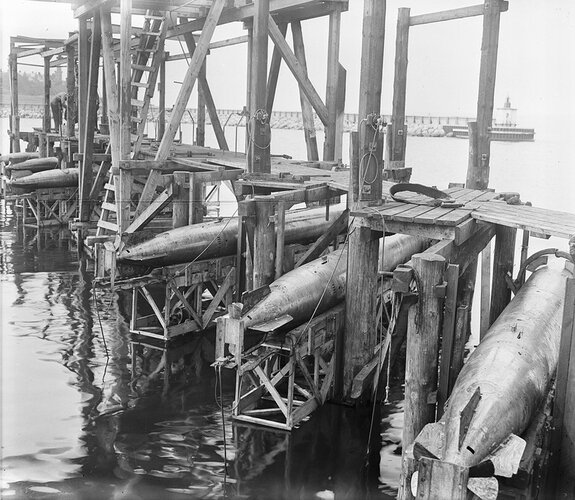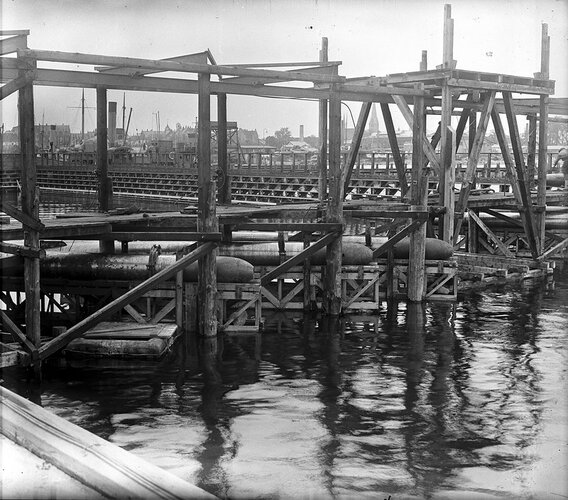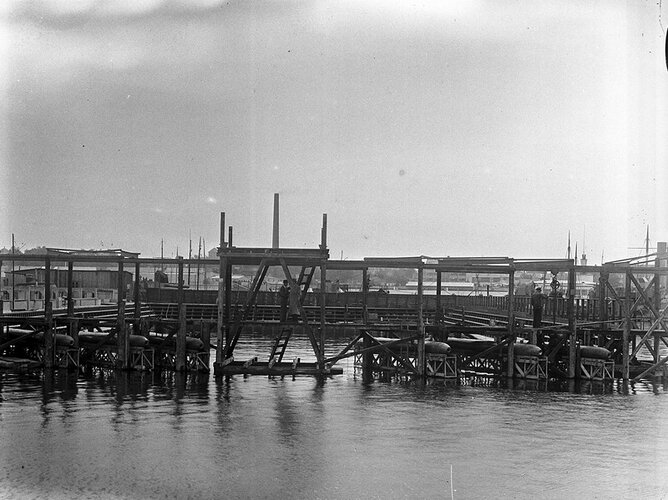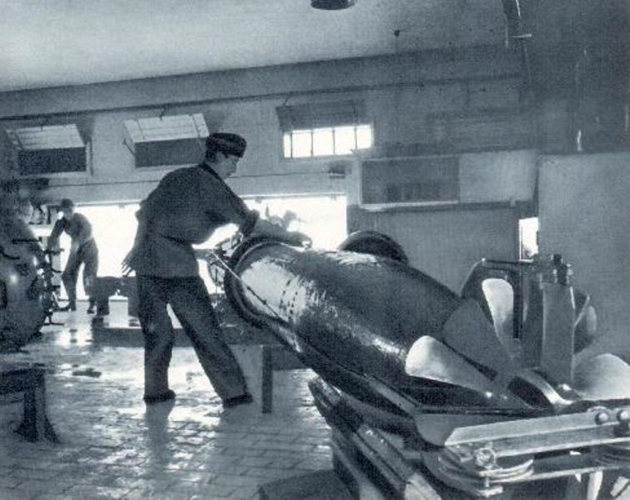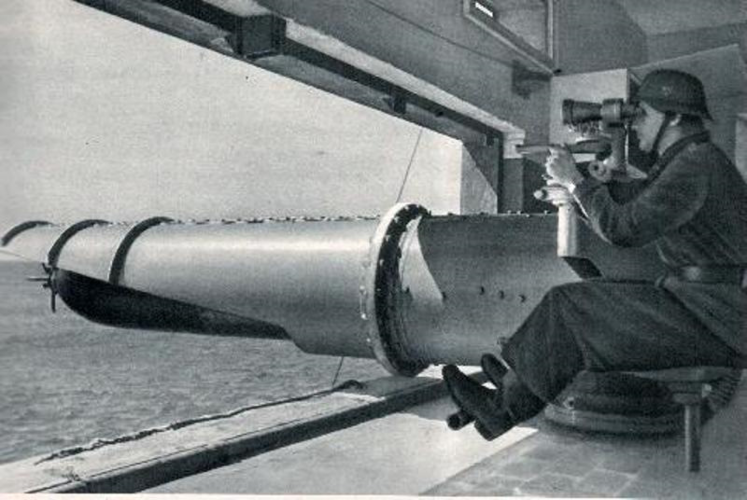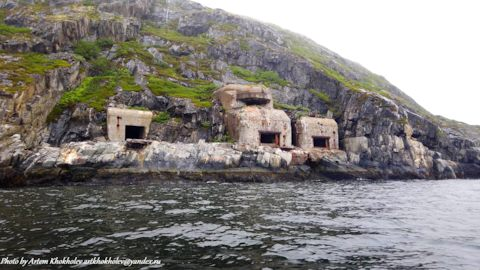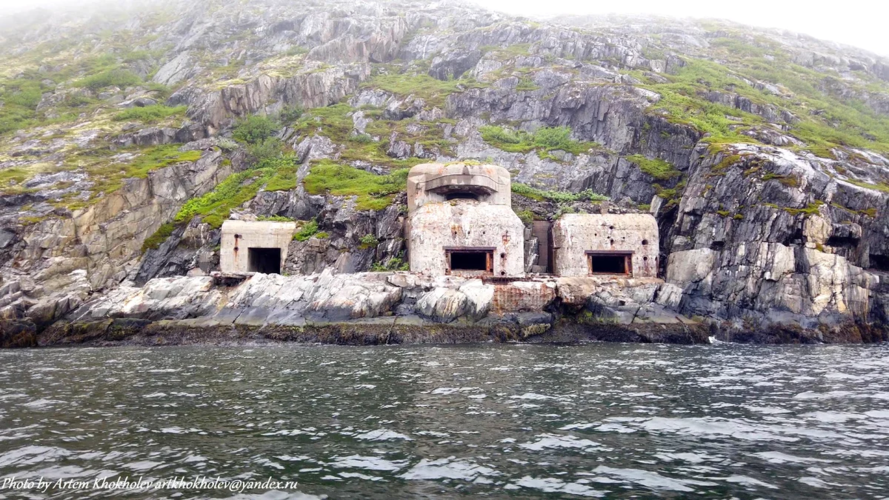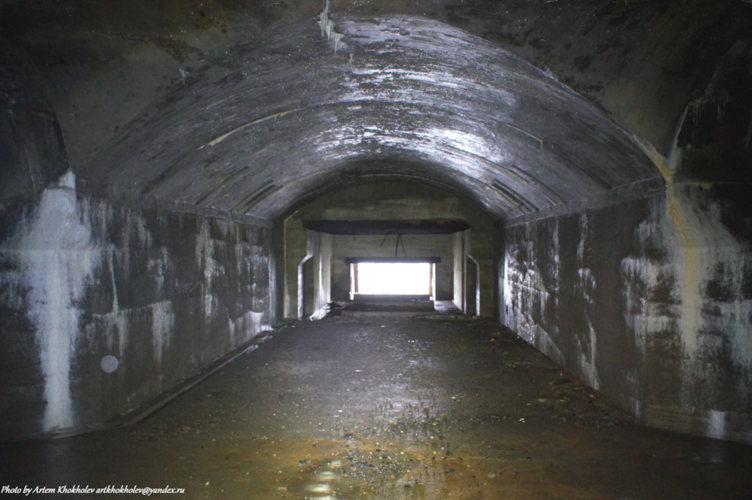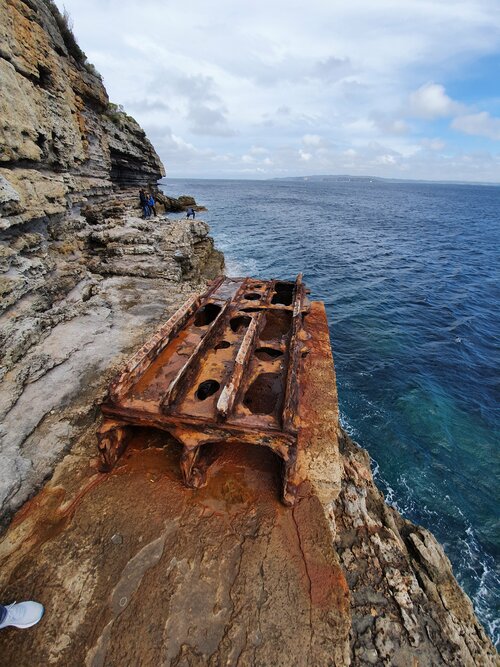Could anyone provide me data and informations about fixed torpedo tubes for shore defence?I known that they saw action during WWII.In one case the German heavy cruiser "Blucher" sunk by two 533 mm torpedoes fired from an Norwegian shore torpedo launcher during German invasion in Norway.Do they still in use today by any naval force or being proposed by any naval warfare design office?
You are using an out of date browser. It may not display this or other websites correctly.
You should upgrade or use an alternative browser.
You should upgrade or use an alternative browser.
Fixed torpedo tubes for shore defence
- Thread starter KonTim
- Start date
- Joined
- 11 March 2006
- Messages
- 8,633
- Reaction score
- 3,489
The use of land based torpedoe tubes in Norway probably is most well known case, but those torpedoes actually
were outdated then.
The only information about nowadays land based torpedoe I've found here :http://laststandonzombieisland.com/tag/shore-based-torpedo/.
But stationing such a weapon will be much more difficult, than a missile battery, I think.
were outdated then.
The only information about nowadays land based torpedoe I've found here :http://laststandonzombieisland.com/tag/shore-based-torpedo/.
But stationing such a weapon will be much more difficult, than a missile battery, I think.
What i have in mind is the use of torpedoes from fixed buy hidden places in narrow sea straits like those who anyone could find to the Aegean,between islands,rocks islets and rocks.I'm aware that the Greek navy has something in mind too.
Are CAPTOR mines considered "fixed torpedo tubes"? These are enCAPsulated TORpedoes with accoustic triggering mechanism, deployed like mines and anchored to the sea floor. When the accoustic triggering mechanism detects the sound of a pre-defined ship or submarine, the capsule opens and the torpedo swims out to go after the target.
These were intended as a means to blockade the routes Soviet submarines would need to take to reach the Atlantic in event of war.
These were intended as a means to blockade the routes Soviet submarines would need to take to reach the Atlantic in event of war.
Nick
ACCESS: Confidential
- Joined
- 24 September 2009
- Messages
- 110
- Reaction score
- 125
The only ones I know of are the original 1880s installations of Brennan Torpedoes at various British military forts along the Thames and elsewhere. The British use of these ended in 1906, though I wouldn't be surprised to hear of this idea being resurrected during WW2.
- Joined
- 18 March 2008
- Messages
- 3,529
- Reaction score
- 880
Nick said:The only ones I know of are the original 1880s installations of Brennan Torpedoes at various British military forts along the Thames and elsewhere. The British use of these ended in 1906, though I wouldn't be surprised to hear of this idea being resurrected during WW2.
Interesting to hear that the British used coastal torpedoes in a river estuary. It was my understanding that the main reason coastal defence torpedoes were a Norwegian phenomena was their fjords provided the deep water needed to operate torpedoes. Though a quick search of the internet shows that the Brennan torpedo was a shallow, fixed depth runner (needing to expose its aiming post so as to be guided to the target) which probably explains the difference. The world’s first guided weapon designed by an Australian!
Most everyone else without deepwater fjords used the other (original) torpedo for coastal defence, that is the fixed sea mine. And in the 20th century command detonated mines that would be laid in fixed patterns and a shore based plotting station would determine the location of the approaching ship and the engineer in charge would complete a circuit to ignite the required mine. Kind of like a one sided game of Battleships.
- Joined
- 12 July 2008
- Messages
- 394
- Reaction score
- 134
Water depth doesn't matter much if you fire the torpedo out of a submerged tube, which was typical in Norway. Its not going to plunge after its fired in this manner. Norway liked torpedoes because you basically couldn't miss in the narrow waterways, and some but not all fjords were too deep for mines.
The Germans installed naval surface torpedo launchers at several points in Norway which were above water and did need significant depths of water, as did similar 24in torpedo batteries in Japan at Tsugaru Strait and other locations. Around the time of Overlord the Germans actually had a plan to install over 200 coastal torpedo batteries in France, but I don't think a single one was actually completed. No idea how those were to be installed, but in reality you could just slide the torpedo into the water on a sloped rail if you wanted and it wont plunge.
The British used torpedoes for a period because they were always looking for a lower cost means of shore defense after that nasty experience building armored forts in the 1860s which were obsolete so quickly in the face of improved ironclads. In the end the torpedo did win, but mounted on submarines, while guns were capped at 9.2in.
The Germans installed naval surface torpedo launchers at several points in Norway which were above water and did need significant depths of water, as did similar 24in torpedo batteries in Japan at Tsugaru Strait and other locations. Around the time of Overlord the Germans actually had a plan to install over 200 coastal torpedo batteries in France, but I don't think a single one was actually completed. No idea how those were to be installed, but in reality you could just slide the torpedo into the water on a sloped rail if you wanted and it wont plunge.
The British used torpedoes for a period because they were always looking for a lower cost means of shore defense after that nasty experience building armored forts in the 1860s which were obsolete so quickly in the face of improved ironclads. In the end the torpedo did win, but mounted on submarines, while guns were capped at 9.2in.
- Joined
- 9 October 2009
- Messages
- 21,147
- Reaction score
- 12,249
Sea Skimmer said:Around the time of Overlord the Germans actually had a plan to install over 200 coastal torpedo batteries in France, but I don't think a single one was actually completed.
According to this 1972 article that JFC Fuller found, some of those batteries were indeed completed, and used the Spinne/T10 controlled (electric) torpedo:
Moving on to a higher level of sophistication
we come to the controlled torpedo. Most
successful of these was the very aptly named
Spinne (= spider) which was fired from coastal
stations. A fine insulated wire was paid out
and guidance instructions were transmitted
down the wire to the weapon. By day the
torpedo could be instructed to surface briefly
and by night to flash a lamp in order that the
operator could track its path. Observation
posts were situated high on cliffs and up to
three weapons could be controlled by each
operator. Known also as T10, the weapon
had a range of 5,400 yards and a speed of 30
knots. These weapons were set up along the
French coast in 1944 but appear to have been
of dubious effectiveness. They did inspire the
British work on wire control of torpedoes,
however, which led to the present wire-guided
U.K. Mark 23.
More on the Spinne: http://forum.axishistory.com/viewtopic.php?f=70&p=1606931
From the same AHF topic, some information on the 'Spinnebatterien', courtesy of AHF member Natter:
Picking up the "Spinne"-thread again. This is from a british document (very poor quality, so there might be a few errors due to problems of interpreting the text). I have omitted several references in the text, which seem to refer to specific intelligence-reports, as they are both hard to read and probably not of much interest (if anyone need them, just let me know).
(unreadable ) NAVAL SECTION
TOP SECRET "U"
29.7.1944
(unreadable reference)
THE USE FOR COASTAL DEFENCE OF THE REMOTE-CONTROLLED TORPEDO "SPINNE"
1. Introduction
Since 7.6.44 references have appeared to a new type of coastal defence which bears the code-name "SPINNE" (Spider).
2. Description of the weapon
The defence have the form of a remote-controlled torpedo, launched from a beach or mole, to be used by the germans for the protection of ports against the approach of enemy vessels. The torpedo is electrically controlled from the shore by a cable, has a range of 6000 yards, and a speed of 30 knots. Several torpedoes can be launched simultaneously.
3. Administration
Torpedoinspectorate KIEL appears to be the chief authority concerned with "SPINNE", the torpedo trials department being responsible for arranging trials trough the local torpedo commands. Reference has also been made to "SPINNE" Torpedo Kommando ROTTERDAM.
Local torpedo commands at CHERBOURG, BREST, LORIENT, ST.NAZAIRE, LA PALLICE, BORDEUX and TOULON have all been concerned with the construction of "SPINNE" installation.
Request for supplies are made through Gruppe East O Qu, and materials are being supplied by Torpedo Arsenal West, PARIS and Torpedo Arsenal TOULON.
4. Location of "SPINNE" installations
"SPINNE" batteries are being constructed on the Atlantic and Mediterrenean coasts of FRANCE. The chief ports are affected. Already exisiting defences such as cable-barrages etc, are being replaced by "SPINNE" but will remain as additional defences.
i. Installations for "SPINNE" have already been constructed at LA PALICE, MARSEILLES and TOULON.
At LA PALLICE, mole apparatus trials were scheduled for after 29.6, but on 15.6 Torpedo Command LA PALLICE reported that the lowering device for the mole battery could not be completed before the end of june.
At MARSEILLES (landpoint) trolley trials were to take place on 25.6.
The final trials of "SPINNE" were to be held at TOULON after 23.6. Six torpedoes were to be used for the trials and afterwards made available for operations.
ii. Installations for "SPINNE" are also under construction at the following places:
a. BREST:
Constructional work for "SPINNE" is probably being carried out in the BREST area. Torpedo Command BREST was asked by Gruppe West O Qu on 13.6 to state its ground cable requirements for the torpedo.
b. LORIENT:
There is construction work for the new defence proceeding in the LORIENT area. Journeys to DOUARNENEE (? ...it's hard to read this word) and AUDIERNE from LORIENT were considered necessary in connection with "SPINNE" and Torpedo Command LORIENT was asked on 13.6. for its ground cable requirements for "SPINNE".
c. ST. NAZAIRE:
A site at FORT DE LEVE has been proposed but there has been no evidence of work having commenced.
d. POINTE DE GRAVE (opposite ROYAN, at the north of the GIRONDE):
This position would not be ready until the end of of July, owing to the construction of a "floating ram".
e. AGDE:
The construction of this position was reported delayed on 30.6 owing to the lack of fuel and oil for TODT*. A gap for "SPINNE" was left when a minefield was laid out off AGDE on 12.7. The minefield, which consists of three rows, was laid from 4317.2N, 0331.9E to 4316.3N, 0331.1E.
f. SETE:
Construction of the SETE position has also been delayed by the lack of fuel for TODT*. There is a control post, possibly belonging to "SPINNE" on the inner mole.
g. "SPINNE" installations in the area of S.D.C. LANGUEDOC, referred to as 17A, 15B, 12A, 14B and 13A were reported under construction on 13.7. At 17A the shelter was completed. The area of S.D.C. LANGUEDOC includes AGDE, SETE and MARSEILLES.
*Organisation TODT.
5. Personell
Personell who have been mentioned in connection with "SPINNE" are:
Capt von SCHEMERMARK of Gruppe West.
Sublt. (Torp.) KREFELD who was at one of the "SPINNE" installations in the LORIENT area.
Organisation TODT and Pioneer Group are carrying out constructional work for "SPINNE".
From an earlier post in the same thread, again by Natter:
Content of a document called "Intermediate report no. 2 on operation "SPINNE" giving the status on 4.7.1944" (dated 8.7.1944). Red text = my comments:
A: Torpedoes
1. 66 torpedoes have been delivered. Of these, 15 have reached the Ostend area, 9 the Atlantic coast, and 12 Toulon. 30 are on the way (24 to Toloun, 6 to Bordeaux).
2. The present rate of delivery by DWK is 2 torpedoes a day.
3. In the tests for internal pressure at 1,5atm (same as for G7a and standard G7e) and also after the transport to the place for operations, the glass discs for the after-part door were cracked; this was remedied by reducing the pressure to 0,75atm and by exchanging the glass discs for better ones (prepared according to the new cooling process) and by placing a rubber packing underneath.
4. TVA experiences in the SPINNE tests:
With a water deptht of 0,5m above the torpedo, the starts are still satisfactory. When the torpedo breaks surface, after the "up" command, it makes sudden eneven, unaccountable changes of course (see Fl b).
B. Steering and firing-off
1. The TVA tests showed that the 24 Volt accumulator, as given by SAM, can only satisfy the requirements when no loss of voltage occurs. With a drop in voltage, the performance of the accumulators is no longer sufficient to transmit satisfactory commands. Consequently the installations with this accumulator is not sufficient in operations. Owing to transport conditions, the measures to be taken are extremely difficult. Measures have been introduced.
3. Positions with regard to construction and dates of termination
(a) Admiral, Channel Coast
(aa) The mole firing-posts at Zeebrügge, Ostend, Dunkirk, Calais and Boulogne were nearly ready when the invasion began.
The following will probably be ready for use:
Zeebrügge on 5.7.44
Ostend on 1.7.44
Dunkirk on 1.7.44
Calais on 30.7.44
Boulogne on 15.7.44
(bb) The continuation of the construction and the completion of the firing-points in Fecamp, Le Havre, Port-en-Bessin and Cherbourg had to be discontinued when the invasion began. It is intended that the 12 SPIONNE-torpedoes which thus become available shall be placed at the disposal of the Admiral South Coast of France for a further 4 Spinne carriage - firing-points.
(b) Admiral, Atlantic Coast
According to the latest reports of the Naval Construction Offices concerned, the state of development is as follows:
Douarnenez: The mounting of the starting device has begun.
Audierne, Beg-Meil, Larmor Plage: Anchorings with drag-drops are laid out. Splinter-proof stands are being constructed.
Turballe: Nearly completed.
St. Nazaire: Mounting of the starting device has begun.
La Pallice: The installation will be ready on 1.7.44. The cabling is still lacking.
Royen Mole: The installation itself which was completed, the winch, crane etc., were destroyed by enemy action. Reconstruction is in course.
(c) Admiral, South Coast of France
Work in the principal sites (Marseilles, Bandol, Hyeres), which had made good progress previously, came to considerable stand-still after 6.6.1944 - with the exeption of Marseilles - since the Todt organisation doing the fitting-up of the position here, had been removed to the rear by order of the Supreme Command.
When the TEK investigation has been carried out, Marseilles will be quite ready for use, and Bandol and Hyeres will be ready in about 10-14 days.
(d) Material Equipment
Admiral, Channel Coast
The mole-firing points at Zeebrügge, Ostend, Dunkirk, Calais and Bolougne are fully equipped with discharge stands, underground cables and other apparatus. There are 15 spinne torpedos in the area.
(e) Admiral, Atlantic Coast
Torpedo Command in Lorient is equppied with 12 torpedo-carriages and 6 spinne-torpedoes with fittings for the installation at Douarnenez (M), Audierne, Benodet, Beg-Meil and Larmor-Plage (W).
Torpedo Command in St. Nazaire has 3 torpedo-carriages for Turballe and St. Nazaire; Torpedo Command in La Pallice has 3 spinne-torpedoes and fittings.
For further equipment, see D3, last paragraph.
(f) Admiral, South Coast of France
Torpedo Command in Toulon, as the Command concerned with the whole of the Southern Area, has so far received:
1. 48 departure carriages with all the accessories.
2. 12 spinne-torpedoes.
F. Tests
(a) As TZ 2 (magnetic Pistol) which had been planned, is not serviceable for the time being because of too high sensitity to disturbance at the "up" command, tests are being carried out with the MZ-part switched off when this command is given. Equipment for operations is therefore Pi 1, if possible already inserted in the warhead.
(b) TVA reported that, in individual torpedoes, every command was not always carried out and that very often, after the "up" command, the torpedoes make incalculable, jumpy changes of course. The pronouncements by SAM are in opposition to this. Since the deployment of the apparatus was called in question because of this want of clearness, the next 10 apparatus had to be placed at SAM's disposal for firing tests at TVA. This caused an interruption of the production for the front of about 14 days.
Note: The map in my previous post above was attached to this memo.
(see attachment for mentioned map [poor image quality, revised scan not yet submitted])
A fair bit more information on Spinne and related installations, can be found throughout the thread.
Attachments
- Joined
- 11 March 2006
- Messages
- 8,633
- Reaction score
- 3,489
As the control of the T 10 needed visual observation, the target probably was alarmed and the
element of surprise was lost. Worse, the course of the torpedo could be backtracked , maybe with
fatal results for the torpedo battery. That could be a reason for the unsufficient effectiveness.
element of surprise was lost. Worse, the course of the torpedo could be backtracked , maybe with
fatal results for the torpedo battery. That could be a reason for the unsufficient effectiveness.
- Joined
- 11 February 2007
- Messages
- 2,103
- Reaction score
- 3,114
Sea Skimmer said:in reality you could just slide the torpedo into the water on a sloped rail if you wanted and it wont plunge.
As can be seen in the picture of the Fort Cliffe Brennan installation in the wiki article on the Brennan torpedo http://en.wikipedia.org/wiki/Brennan_Torpedo
The British used torpedoes for a period because they were always looking for a lower cost means of shore defense after that nasty experience building armored forts in the 1860s which were obsolete so quickly in the face of improved ironclads. In the end the torpedo did win, but mounted on submarines, while guns were capped at 9.2in.
Coast defence guns weren't absolutely capped at 9.2", Singapore got five 15" guns in the late 1930s, and two 12" guns were installed in the 1920s to cover the mouth of the Tyne http://en.wikipedia.org/wiki/Tyne_Turrets
- Joined
- 12 July 2008
- Messages
- 394
- Reaction score
- 134
Jemiba said:As the control of the T 10 needed visual observation, the target probably was alarmed and the
element of surprise was lost. Worse, the course of the torpedo could be backtracked , maybe with
fatal results for the torpedo battery. That could be a reason for the unsufficient effectiveness.
How exactly are you going to backtrack an electric torpedo? They don't leave a wake, and if fired from underwater or a well concealed spot in general no sign will exist they have been fired. In fact such a weapon could be devilishly effective. The signs of firing in no case will be more obvious then the smoke and flash of coastal guns!
Heavy guns and ammunition are very very expensive themselves. A US 16in coastal gun installed with mount cost around 700,000 dollars in 1920, with the shells being about 1,000 dollars each. This buys the gun sitting on the ground on its mount, no protection, no magazines, no power plant ect... and certainly no fire control.
In contrast a torpedo was around a 10,000 dollar item. Now, the 16in gun certainly had far more useful range then any torpedo, but the point being big battleship weapons are very expensive. Yet even the worst torpedo can damage an enemy battleship or even sink it. A battery of much smaller and cheaper, medium caliber guns meanwhile meanwhile will still far outweigh the cost of a torpedo battery, and importantly require far more men for its operation and defense. It wont be effective at all against an invasion backed by capital ships. As shown as Normandy when a dozen plus German gun batteries generally of 15cm or 21cm class managed to sink only one allied destroyer and damage a few other vessels.
The only German radars that could control heavy gunfire blind were very large, which means had to protect and conceal, and generally rare in the coastal role, so the need for visual observation applied to guns as well as torpedoes.
DWG said:Coast defence guns weren't absolutely capped at 9.2", Singapore got five 15" guns in the late 1930s, and two 12" guns were installed in the 1920s to cover the mouth of the Tyne http://en.wikipedia.org/wiki/Tyne_Turrets
Yes sure, in the very long run they were not, but your talking about a very long period, maybe 50 years? after the Dover turret and 17.72in guns in the Med, in which they were, and during which the overwhelming majority of the modern coastal defenses of the Empire were installed. Another pair of 15in guns were also installed at Dover in 1942, they had been earmarked for Singapore. Once might also contend that several of the 14in and 18in railroad weapons deployed around Dover counted as coastal weapons, though the ability to engage moving ships was very limited. All of this except the Singapore guns were war emergency measures, and not part of peacetime policy. Big contrast to just about everyone else on the planet who had serious coastal armament at all.
- Joined
- 1 May 2007
- Messages
- 2,537
- Reaction score
- 1,752
Sea Skimmer said:Jemiba said:As the control of the T 10 needed visual observation, the target probably was alarmed and the
element of surprise was lost. Worse, the course of the torpedo could be backtracked , maybe with
fatal results for the torpedo battery. That could be a reason for the unsufficient effectiveness.
How exactly are you going to backtrack an electric torpedo? They don't leave a wake, and if fired from underwater or a well concealed spot in general no sign will exist they have been fired. In fact such a weapon could be devilishly effective. The signs of firing in no case will be more obvious then the smoke and flash of coastal guns!
I think Jemiba was referring to the T 10 guided torpedo, rather than torpedoes in general...
cheers,
Robin.
- Joined
- 11 March 2006
- Messages
- 8,633
- Reaction score
- 3,489
robunos said:I think Jemiba was referring to the T 10 guided torpedo, rather than torpedoes in general...
Indeed, see #8 by Grey Havoc : "...By day the torpedo could be instructed to surface
briefly and by night to flash a lamp in order that the operator could track its path. Observation
posts were situated high on cliffs and up to three weapons could be controlled by each
operator."
The same principle was chosen for some remotely controlled explosive boats, but those relied
more on speed.
- Joined
- 9 October 2009
- Messages
- 21,147
- Reaction score
- 12,249
Jemiba said:As the control of the T 10 needed visual observation, the target probably was alarmed and the
element of surprise was lost. Worse, the course of the torpedo could be backtracked , maybe with
fatal results for the torpedo battery. That could be a reason for the unsufficient effectiveness.
If they had been able to mass produce the best version of the Spinne, matters might have been different. From another post by Natter:
Gerät 43a: Had both roll- and course control. The rotary transformer was replaced by a bridge-control and bridge providing electrical stabilization and rudder-control. Each course-control command produced a 2 degree change in course (post-war wire-guidance modificated norwegian G7a could be controlled by steps of 1 degree). This variant proved to be very reliable but was not put into production due to the lack of manufacturing facilities.
Gerät 43d: The electrical stabilization and rudder control was replaced by a "specht" (a device consisting of 3 solenoids). The specht would disconnect the gyroscope on first course-command received, after that the rudder could only be kept in full port, full starboard or center posistion. Disadvantage: No gyroscope control of the course, ie the torpedo had to be brought to the surface for visual control. Advantage: Easy stering and the torpedo could be set to circle. This was the variant put in production for the shore-defence of France, Denmark and Germany (this may indicate no "Spinnebattery" in Norway, but on the other hand: Batteries have been confirmed in Holland).
Any details on the above photos?
Dilandu
I'm dissatisfied, which means, I exist.
I just watched a clip in Youtube from the Norwegian film the Kings Choice, I now want to watch the whole thing although I will have to watch it in stages, I loose the trail in captioned movies.
The scene that drew me to watch the various clips was the sinking of the Blucher which was really done well including the torpedoing.
The scene that drew me to watch the various clips was the sinking of the Blucher which was really done well including the torpedoing.
David Chessum
ACCESS: Restricted
Some more info here on the Jervis Bay ones:

 jervisbaymaritimemuseum.blogspot.com
jervisbaymaritimemuseum.blogspot.com
Jervis Bay - World War Two – The “Tubes”
History of Jervis Bay region told through everyday stories from the past.
Dilandu
I'm dissatisfied, which means, I exist.
Oh. My apologies.I don't appreciate the fact that photos are copied/stolen without giving any credit/information on sources (and it's against forum-rules as well)...
David Chessum
ACCESS: Restricted
I found out today that the RAN also mounted shore-based torpedo tubes at Fort Tomaree, on the southern side of the entrance into Port Stephens, north of Newcastle in NSW during WW2. According to signage at the site, the tubes were removed in 1943, and returned to Sydney.
There is nothing left onsite now except what may be the remains of the stone plinth they were mounted on.
Regards
David
There is nothing left onsite now except what may be the remains of the stone plinth they were mounted on.
Regards
David
- Joined
- 9 October 2009
- Messages
- 21,147
- Reaction score
- 12,249
Regarding the British shore torpedo batteries of the late 19th and early 20th centuries, would the Royal Garrison Artillery (and it's immediate RA predecessor organisation on the coastal defence side of things) or else the Royal Navy been responsible for manning and operating them? I don't think the Royal Marine Artillery ever operated such installations, though I could of course be badly mistaken there. I presume any shore torpedo batteries operated during the interwar period (at least post-1926) and during WWII were primarily under Royal Artillery jurisdiction?
- Joined
- 11 February 2007
- Messages
- 2,103
- Reaction score
- 3,114
Regarding the British shore torpedo batteries of the late 19th and early 20th centuries, would the Royal Garrison Artillery (and it's immediate RA predecessor organisation on the coastal defence side of things) or else the Royal Navy been responsible for manning and operating them? I don't think the Royal Marine Artillery ever operated such installations, though I could of course be badly mistaken there. I presume any shore torpedo batteries operated during the interwar period (at least post-1926) and during WWII were primarily under Royal Artillery jurisdiction?
I'd presume RGA given they were largely in coastal defence installations already run by RGA.
ETA The Royal Marines - 1 RM Coast Brigade, later 1 Royal Marine Coast Artillery Regiment - did operate coastal guns in Sri Lanka in WWII, so it's possible the RMA had operated them previously.
Last edited:
shin_getter
ACCESS: Top Secret
- Joined
- 1 June 2019
- Messages
- 1,010
- Reaction score
- 1,329
I'm just reading up on modern torpedoes with something like 70nm range. It appears to me that such weapons can be combined with SOSUS style network and be land based.
Has anyone analyzed if such a weapon would fit South China Seas, Taiwan straits or Strait of Hormuz, whether there has been any (suspected) installation and planned countermeasures upon encountering such weapons.
"Shore Based Platforms" is on torpedo marketing material after all!
Has anyone analyzed if such a weapon would fit South China Seas, Taiwan straits or Strait of Hormuz, whether there has been any (suspected) installation and planned countermeasures upon encountering such weapons.
"Shore Based Platforms" is on torpedo marketing material after all!
I think that and a return to coastal defense guns is called for what with terrorists.
There will never be a “regular” hijacking again…not here. The Texas City Disaster will get them to think about ship bombs.
You saw what fertilizer did in Beirut 2020.
So did everyone else.
There will never be a “regular” hijacking again…not here. The Texas City Disaster will get them to think about ship bombs.
You saw what fertilizer did in Beirut 2020.
So did everyone else.
- Joined
- 11 March 2006
- Messages
- 8,633
- Reaction score
- 3,489
When I was reading "Festungsbau an Nordsee und Ostsee" (Fortress Construction at the North Sea and Baltic) by Frank Gosch during the recent holidays, I stumbled upon a description of two torpedo batteries, that were built during 1909/1910 in the coastal fortification of Pillau. It consisted of an underground room, made from concrete, partially filled with water and closed to the sea by an iron door. Three torpedo tubes could be lowered into the water in that room, and, when that door had been opened, launched from an armoured control room, positioned above this installation.

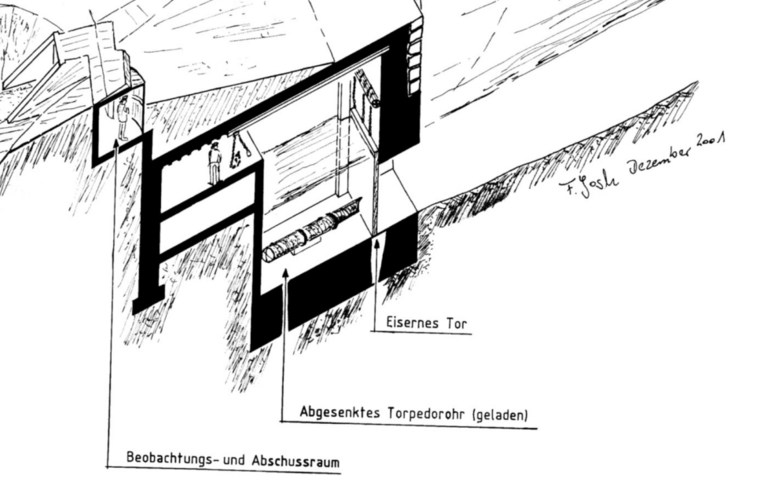
World B4
my bad y'all
- Joined
- 25 June 2017
- Messages
- 397
- Reaction score
- 315
Rabaul
3/4 of the way down the page

 www.militaryimages.net
www.militaryimages.net
3/4 of the way down the page

Photos - WW2 Japanese Forces
Machine gunner training with Type 11 Nambu (with a field mod foregrip)
Similar threads
-
Royal Navy coastal forces in the early Cold War period.
- Started by Comrade Dave
- Replies: 9
-
-
-
Royal Netherlands Navy fleet tanker program [1939-40]
- Started by Grey Havoc
- Replies: 9
-


